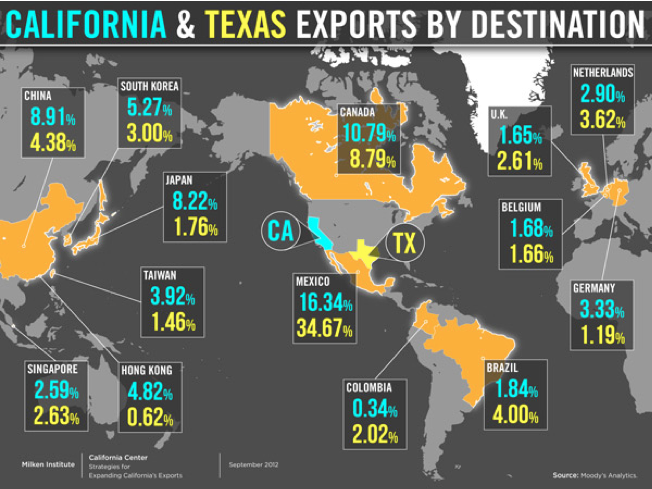As Texas Governor Rick Perry stumps around California attempting to recruit businesses to the Lone Star State, he brings an underlying message: Texas is better for business than California. When we look at these two powerhouse state economies, both with significant oil and gas resources and strong economic drivers, we see some marked differences. The regional-economics territory is familiar to the Milken Institute research staff, who have been studying California and Texas for years using various yardsticks.
There is no question that Texas has a lower tax and regulatory burden, and a lower cost of living. But California continues to maintain significant advantages in terms of high technology, research universities and developing innovations. Still, California’s higher costs and a difficult-to-navigate regulatory system mean that a split has developed. While research and development and innovation are more likely to stay in California, companies often expand or move their back offices and new manufacturing to Texas.
Both California and Texas have fared well in our most recent indexes of Best Performing Cities. In 2012 San Jose took the top spot, followed quickly by Austin at number two. Overall in the index, Texas had three of the top-ten large metro areas, compared to a single metro area for California. The growth in wages and high tech played a critical role for California’s Silicon Valley, overwhelmingly concentrated in a single region in the state.
Best Cities for Successful Aging
In our Best Cities for Successful Aging report, which looks at the myriad factors that determine quality of life and opportunity for the growing group of older Americans, neither California nor Texas made it into the top ten large metros list. Provo, Utah took the top spot. In the top twenty five, San Francisco came in at eleven and San Diego at twenty five. No Texas metros made the list, reflecting the fact that Texas cities often lag quite far behind in many community resources, such as public transportation, that are important for an older population. This ranking looked at more than eighty different criteria, including weather, medical care and economic conditions.
In our report, Strategies for Expanding California’s Exports, we frequently compared California and Texas and discovered a few surprises. Success in exports is one of the key areas where Texas has clearly shone in comparison to California. Not only has Texas decisively taken over the lead from California as the largest exporting state in the U.S., it has also consistently grown its exports faster than the national average by pursuing strong linkages with Mexico, under the North American Free Trade Agreement (NAFTA), and encouraging companies engaged in exports to Latin America to locate operations in the state. By contrast, even though California is very well positioned as a gateway to Asia, it has lacked a comprehensive trade and export strategy for more than a decade, and has seen its export growth fall below the national average. Facilitating exports for small and medium sized businesses in California to emerging markets in Asia and Latin America provides a key for the state to vault past Texas and return to leadership in the category.


